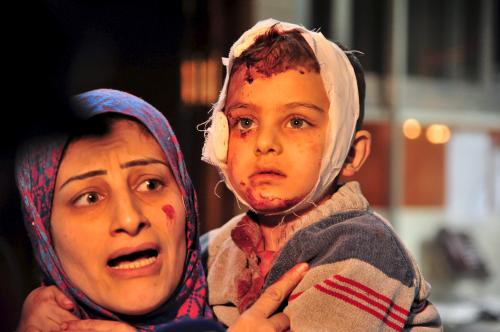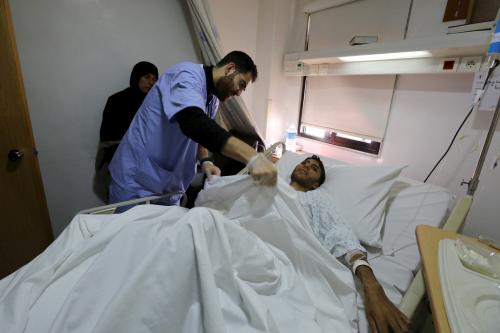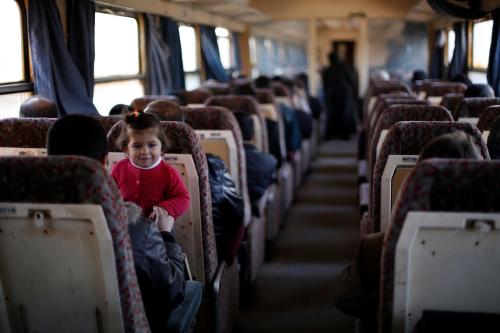In February of this year the Syrian Center for Policy Research issued a report stating that 470,000 Syrians had been killed in the war and 1.9 million wounded. That was 10 months ago and with the intensification of the siege and bombardment of Aleppo and ongoing fighting elsewhere in the country, one can only guess at the current toll. What is clear is that each day of fighting adds to the burden that Syria will have to carry for generations to come, not only in terms of the ever mounting physical destruction but also in caring for the growing daily toll of the physically or mentally disabled that the war produces. All this at a time when half the population—nearly 5 million refugees and 6.6 million Internally Displaced Person (IDPs)—have been torn from their homes; and the country’s medical system is in tatters.
Globally, around one in seven people or approximately 15 percent are disabled but among Syrian refugees this number climbs to 22 percent according to a 2013 Survey, higher than the 18-20 percent estimated for most other conflict areas. Similarly, while globally it is estimated that 2-4 percent of the disabled experience significant difficulties in functioning, the number of those with severe impairments rises to 6 percent among Syrian refugees. If one were to extrapolate these survey numbers—which apply to Syrian refugee populations in Jordan (640,000 registered refugees and a million Syrians overall) and Lebanon (1 million refugees) and include the nearly 2.7 million Syrian refugees in Turkey—the numbers come to slightly over 1 million disabled of whom some 280,000 are severely impaired.
This number would tax most health care systems. It poses a huge burden for the neighboring host countries, especially Jordan and Lebanon where the refugee populations account for between 20 and 30 percent of the native populations. In both countries, international and local nongovernmental organizations as well as humanitarian and aid agencies do try and provide support but the challenges are immense. For example, it is estimated that around 30 percent of Jordan’s Syrian population are either disabled or have a serious health condition. In Turkey, which provides free health care for refugees, the challenges still loom large with language barriers and cultural constraints such as some women refugees’ insistence on female doctors. In all three countries the specialized medical needs of disabled people, especially those with psychological and mental needs, remains particularly problematic.
Syria’s 6.7 million IDPs are mostly limited from easy access to humanitarian assistance and face woefully inadequate medical services. According to the U.N., the overall number of Syrians in the country who currently need assistance is 13.5 million and 4.5 million live in what are termed “hard-to-reach” areas. These are scattered in 147 locations across the country. The number of disabled people is estimated to be in the hundreds of thousands with thousands more listed as severely impaired. Every month, the U.N. is able to provide only 373,000 medical treatments.
There are also nearly 400,000 people within Syria who are being besieged according to the U.N., but Siegewatch puts the number at nearly a million with another 1.4 million under siege-like conditions or under danger of being besieged. Whatever the actual numbers, the reality is that tens of thousands of disabled Syrians live with very little or no medical attention.
Disabled women are especially vulnerable. “About a third of women with disabilities experience psychological, sexual, or physical abuse in natural disasters and conflicts, according to a 2015 report by Handicap International…Women with disabilities who are isolated in their homes are particularly at risk of sexualized violence and rape, as are girls with intellectual disabilities,” said a February 2016 report by the New York-based nonprofit Women’s Refugee Commission. Access to everything from bathrooms to medical care to educational and other services is also particularly difficult for women—especially given the cultural context for many Syrian refugees.
Another group of disabled with specific vulnerabilities include children, whose plight was highlighted by UNICEF’s The State of the World’s Children 2013: Children with Disabilities. The dire situation presented in the report—some 93 million children or one in 20 of those aged 14 or younger, living with a moderate or severe disability of some kind—has only worsened as highlighted by the wars in Libya, Iraq, and Syria. Older refugees are perhaps even more vulnerable. Of the elderly Syrian refugees, 66 percent have an impairment, 33 percent of these are severe, and 65 percent of them suffer from psychological distress.
While disabled Syrian refugee swimmer, Ibrahim Al-Huseyin led the Independent Paralympic team into Maracanã Stadium behind the flag of the International Paralympic Committee, moments of recognition and acknowledgement are few and far between for the world’s disabled refugees and IDPs. In 2011 only 1 percent of humanitarian aid reached old people and the disabled. It is likely that this has gone up since then, as has the numbers of disabled due to population aging and the rapid spread of chronic diseases, as well as improvements in the methodologies used to measure disability. However, the relatively meager increases in funding do not appear to be nearly commensurate with the needs of this population. The disabled represent a significant cost and source of tensions and stress for refugee communities. Assistance to this population helps immensely with the challenges of familial and social resilience for refugee populations. A community whose most vulnerable are taken care of is much more likely to better integrate and more effectively assist with rebuilding their communities.
The Brookings Institution is committed to quality, independence, and impact.
We are supported by a diverse array of funders. In line with our values and policies, each Brookings publication represents the sole views of its author(s).








Commentary
Disabled and forcibly displaced
October 27, 2016